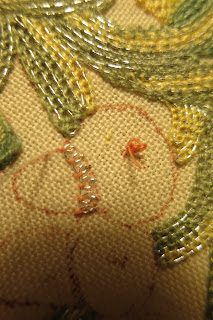I've started working on the clothing of the two figures. Most of it is done in detached buttonhole. . . with occasional other stitches mixed in here and there.
For me, the real challenge of this stitch is keeping it looking neat and clean. It doesn't take much to create a messy look. And for clothing, there's the additional issue of the order of work and how to make the various clothing sections work smoothly together.
What I've tried to to is think about which individual clothing parts logically sit atop one another and work in that order.
Here's what I've been working on thus far:
I started with the wife, with the center of the hat. . . but am still trying to decide what hat section would be best done next. So I moved on to the little loops that form the collar. . . then the sleeves of her dress.
Next I stitched the left side of the bodice. . . and started on the right side. The left side I like, but I'm still fussing to get the right side look balanced with the left side. While I stewed about that, I stitched the right side of the skirt. This shows some of the issues with stitching these complex shapes neatly. In this section I added several partial rows to make the skirt shape flare out a bit. Even done as neatly as humanly possible, they tend to look a little messy.
There's a little section of what I assume is an underskirt of some kind along the left side of the skirt. Since I think the other skirt sections would lie above this, I stitched it next. It's done in ceylon stitch, but since the shape is so tiny, the section begins with a single column, widening out to two. I love that the petticoat is bright red! What fun.
What's next? I think I'll work on the left side of the skirt. . . then the center apron. I'll leave the rest of the bodice for last since it looks rather tricky. . . with that uncooperative right side of the bodice to unstitch and redo. . .then a wide detached lapel and collar that sits atop the tan main part of the bodice.
Lazy Daisy Pine Needles: The Movie
7 hours ago


























